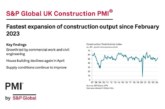
In the June edition of PBM, editor Paul Davies reflected upon the sustained surge in construction activity but cautioned that the twin challenges of product availability and the perennial issue of a ‘skills shortage’ can undermine the recovery.
As you will see from a number of stories later in the issue and also via www.professionalbuildersmerchant.co.uk, it is heartening to report the continuing surge in construction activity — indeed, the industry is at the vanguard of the nation’s emerging economic fightback from the depths of our Covid-induced hibernation.
All manner of sources from across the building spectrum show a pleasing upward trajectory on the graph — almost perfectly showcasing those fabled hopes of a ‘V-shaped’ recovery from when the pandemic first struck.
Whilst the headlines are undoubtedly positive, and goodness knows such sustained upbeat news is so very welcome, it would be remiss not to drill down a little into the data. As a consequence of interrupted production over the duration of the pandemic, pre-Brexit stockpiling and supply chain issues as a result of both, the availability of certain products — such as timber, roof tiles, fixings & fasteners and insulation products — and rising prices are cited as increasingly common concerns.
As the latest instalment in our regular merchant survey, The Pulse, contends, the merchant sector appears to be largely weathering this particular storm thus far — but there is underlying consternation for the months ahead. Our latest report, based on telephone interviews conducted in early April, states: “Ninety-five percent of merchants said that most or all of their suppliers were able to supply them. While this is a significant improvement on April last year (28%), stock shortages, importing issues and long lead times are continuing problems.”
Mid- to long-term sales expectations remain high, underlining the high levels of confidence across the sector as a whole, however reports from the likes of the Federation of Master Builders highlight other areas to be mindful of, in particular a shortage of skilled tradespeople.
The FMB’s State of Trade Q1 2021 survey, for instance, cites that 38% of builders are struggling to hire bricklayers — an increase from 22% in Q4 2020 — and a further 34% are experiencing difficulties in hiring carpenters and joiners (up from 23% in Q4 2020).
Of course, the construction sector skills shortage has a recurring problem for years. Going back to the turn of the millennium, the Blair Government’s notionally laudable focus on ‘Education, Education, Education’ may have increased the numbers going on to university, but it perhaps had the unintended consequence of steering a generation away from the vocational careers that may have been a better fit all round.
How many dissatisfied, underemployed 40 year old Media Studies graduates would have been more fulfilled and financially better off building homes or repairing boilers? I suspect quite a few.
It is a problem the industry has compounded by simply not marketing itself effectively enough over the years as a rewarding, varied and potentially well remunerated career. To an extent, some of the shortfall was masked by an influx of European labour, but as many elect to return to the continent, the real consequences may still lie ahead.
It is important to state that much great work has been done in recent years to boost the appeal of construction, and to devote swathes of time and resource to train the next generation of trade professionals. It is also interesting to note that a growing number of merchant businesses are looking to take a lead, ensuring that if the skills shortage will have an impact on sales across the sector at large, their own businesses will maintain a strong flow of customers — in recent months we have seen many initiatives from enhanced loyalty schemes to affiliated or recommended installer programmes. Many are also sponsoring training courses at local colleges, or even investing in their own installation teams.
As with so many aspects of the post-pandemic future, it will no longer be enough to rely on the tried and trusted measures that worked so well in the past. In terms of both procurement and also the nature of the merchant sector’s relationship with its customers, it will be fascinating to see how the changes play out.
“How many dissatisfied, underemployed 40 year old Media Studies graduates would have been more fulfilled and financially better off building homes or repairing boilers? I suspect quite a few.”









